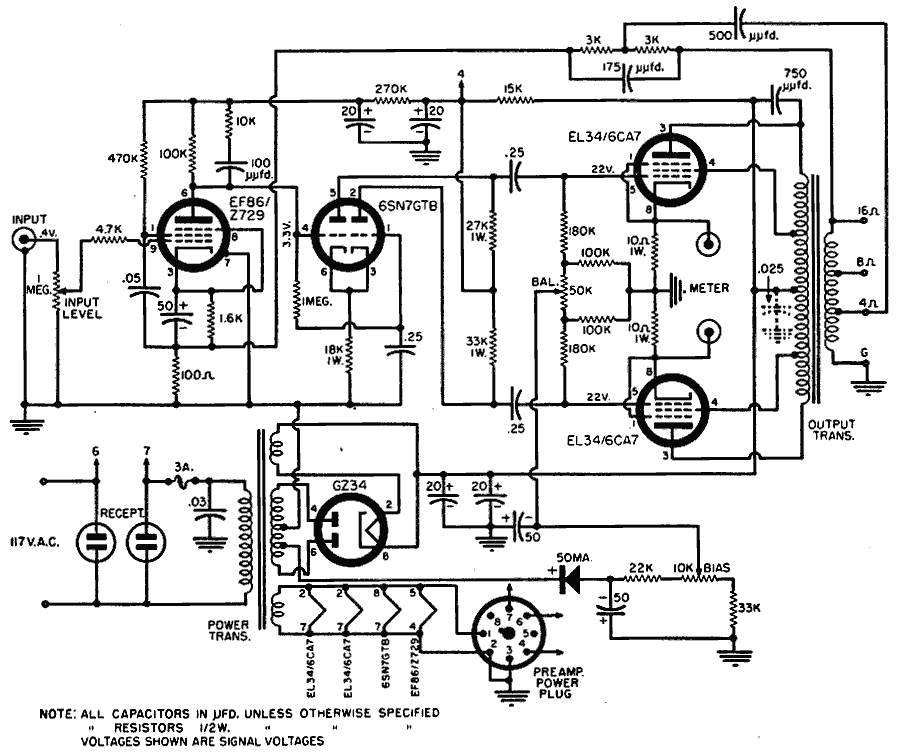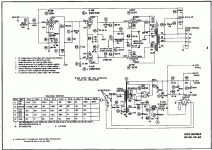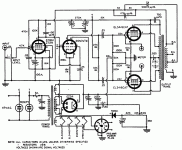Hello all,
This is my first foray into the (apparently obsessive) world of audophile equipment.
The long story made short: I have discerning ears / love jazz. Cleaning out my grandfather's attic, found an old EICO HF-60 (intact with all original tubes/OPT's). He also built himself thiel-parameter-complete speakers with custom cherrywood cabinets to go with it (the man knew his stuff).
Assume the following:
I can read basic circuit diagrams, but might need help with some things (like what a "tap" on an OPT is)
I have access to any and all testing equipment (seriously).
I can solder and breadboard like a boss (lots of digital experience, but more on the coding end).
I've read up on the basics of Mullard topology, tubes, and OPTs in general.
How do I go about testing this bird to see what need to be replaced without killing myself? Should I consider replacing the old can capacitors with new capacitors, considering the drastic advances in capacitor technology?
Furthermore, if I were to build a second one of these from scratch (for a stereo system), would I need to replicate the absurdly hard-to-get TO-330 OPT, or is there a "nearly identical" OPT I could throw in?
Any information is helpful. I will provide photos and full descriptions as this project unfolds.
This stuff is REALLY COOL!
This is my first foray into the (apparently obsessive) world of audophile equipment.
The long story made short: I have discerning ears / love jazz. Cleaning out my grandfather's attic, found an old EICO HF-60 (intact with all original tubes/OPT's). He also built himself thiel-parameter-complete speakers with custom cherrywood cabinets to go with it (the man knew his stuff).
Assume the following:
I can read basic circuit diagrams, but might need help with some things (like what a "tap" on an OPT is)
I have access to any and all testing equipment (seriously).
I can solder and breadboard like a boss (lots of digital experience, but more on the coding end).
I've read up on the basics of Mullard topology, tubes, and OPTs in general.
How do I go about testing this bird to see what need to be replaced without killing myself? Should I consider replacing the old can capacitors with new capacitors, considering the drastic advances in capacitor technology?
Furthermore, if I were to build a second one of these from scratch (for a stereo system), would I need to replicate the absurdly hard-to-get TO-330 OPT, or is there a "nearly identical" OPT I could throw in?
Any information is helpful. I will provide photos and full descriptions as this project unfolds.
This stuff is REALLY COOL!
The tap on the transformer is terminated by a wire. For each tap, you have a wire extending from the transformer. It's the equivalent of a "pin"--If you imagine any modern electronic device, you already know each "pin" must go to the correct destination. Each "tap" (old style) is the same as a modern "pin." It must be connected to the correct part of the circuit...or it won't work correctly.
Transformer for example provides taps for hooking up 4 ohm, 8 ohm, 16 ohm speakers, provides impedance matching depending on requirement of load...select the correct "tap" according to load.
The real sad news is that although modern capacitors are smaller, they are not too much better in actual function compared to their larger ancestors..
Electrolytic Capacitors DO go bad with age. and so it is not such a bad idea to replace old ones with fresh ones.
However, old can capacitors are usually replaced with new can capacitors. Usually restoration of tube amps will use parts as close as possible to the original.
Transformer for example provides taps for hooking up 4 ohm, 8 ohm, 16 ohm speakers, provides impedance matching depending on requirement of load...select the correct "tap" according to load.
The real sad news is that although modern capacitors are smaller, they are not too much better in actual function compared to their larger ancestors..
Electrolytic Capacitors DO go bad with age. and so it is not such a bad idea to replace old ones with fresh ones.
However, old can capacitors are usually replaced with new can capacitors. Usually restoration of tube amps will use parts as close as possible to the original.
I believe I've read in a number of postings by Those Who Know Their Stuff, that under
certain circumstances a bad cap can take out a transformer. That would suck to
That would suck to
waste a TO-330. I assume you're already on the get-a-variac-and-power-up-slow-
to-avoid-spraying-cap-guts-all-over page. This could be a killer thread, I hope it goes
somewhere. Now all I need is an audiophile Granddad...
certain circumstances a bad cap can take out a transformer.
waste a TO-330. I assume you're already on the get-a-variac-and-power-up-slow-
to-avoid-spraying-cap-guts-all-over page. This could be a killer thread, I hope it goes
somewhere. Now all I need is an audiophile Granddad...
JMohin--
I am in the process of refurbishing a pair of HF-12s and just got finished with a 377 signal generator, all from the 1950-55 era. Congrats on your excellent find!
You may find the caps are actually good. (A capacitor tester up to 50uF is very handy.) But if you've got the amp open, you may as well replace all the electrolytics anyway. They will go bad eventually and the cost to change them out is quite low. In general, the ceramics should be left alone. Can caps are a PITA. Replacements can be purchased, or you can buy pencil-shaped caps by Nichicon and restuff the can yourself. Some people ditch the cans altogether and just solder in leaded capacitors. It depends upon your fidelity to the original look.
The resistors should be checked to see if they are in tolerance and replaced as necessary. Switches and pots should be cleaned, though not necessarily replaced. The tubes are usually good and should be kept unless tested bad. (You can buy tube testers on eBay, or you just buy new (or old) tubes and swap them out and compare. The transformers should not be replaced unless they are beyond hope; Eico iron is of exceptional quality.
The Eico stuff is very easy to work on. You do need a 100-plus watt soldering iron to do the work. Mark everything well and save your old parts as reference. Most tube gurus recommend using a Variac to bring up the circuit slowly, which sometimes helps "reform" old caps. If I am replacing all the electrolytics, however, I don't bother with this.
There are several boutique sellers of vintage-style/sounding caps. Sprague Atoms and Orange Drops are very popular. They aren't costly, and people seem to think they are the best for preserving the sound of old tube amps. Resistors can be metal film or carbon. Just make sure you the detailed schematic and parts list. These can be found in a copy of the original manual.
The voltages are high on these amps, so caution must be exercised. The one universal safety recommendation I have seen is to replace the power cord with a proper 3-wire grounded plug. As part of this exercise, the so-called "death cap" should be removed as well.
Good luck!
I am in the process of refurbishing a pair of HF-12s and just got finished with a 377 signal generator, all from the 1950-55 era. Congrats on your excellent find!
You may find the caps are actually good. (A capacitor tester up to 50uF is very handy.) But if you've got the amp open, you may as well replace all the electrolytics anyway. They will go bad eventually and the cost to change them out is quite low. In general, the ceramics should be left alone. Can caps are a PITA. Replacements can be purchased, or you can buy pencil-shaped caps by Nichicon and restuff the can yourself. Some people ditch the cans altogether and just solder in leaded capacitors. It depends upon your fidelity to the original look.
The resistors should be checked to see if they are in tolerance and replaced as necessary. Switches and pots should be cleaned, though not necessarily replaced. The tubes are usually good and should be kept unless tested bad. (You can buy tube testers on eBay, or you just buy new (or old) tubes and swap them out and compare. The transformers should not be replaced unless they are beyond hope; Eico iron is of exceptional quality.
The Eico stuff is very easy to work on. You do need a 100-plus watt soldering iron to do the work. Mark everything well and save your old parts as reference. Most tube gurus recommend using a Variac to bring up the circuit slowly, which sometimes helps "reform" old caps. If I am replacing all the electrolytics, however, I don't bother with this.
There are several boutique sellers of vintage-style/sounding caps. Sprague Atoms and Orange Drops are very popular. They aren't costly, and people seem to think they are the best for preserving the sound of old tube amps. Resistors can be metal film or carbon. Just make sure you the detailed schematic and parts list. These can be found in a copy of the original manual.
The voltages are high on these amps, so caution must be exercised. The one universal safety recommendation I have seen is to replace the power cord with a proper 3-wire grounded plug. As part of this exercise, the so-called "death cap" should be removed as well.
Good luck!
Replace all the caps. Yes new caps -- if you choose the appropriate ones -- are better & smaller than old caps. If you have room a serious sonic upgrade can be made by using all poly caps in the power supply. It could really use a choke too.

As far as OPTs go, it depends on how much money you are willing to spend.
There are definitly do some stuff to improve this circuit (a CCS on the bottom of the LTP for instance)
I like this map better but the other has voltages.

What do the speakers look like?
dave

As far as OPTs go, it depends on how much money you are willing to spend.
There are definitly do some stuff to improve this circuit (a CCS on the bottom of the LTP for instance)
I like this map better but the other has voltages.
What do the speakers look like?
dave
Attachments
I believe I've read in a number of postings by Those Who Know Their Stuff, that under
certain circumstances a bad cap can take out a transformer.That would suck to
waste a TO-330. I assume you're already on the get-a-variac-and-power-up-slow-
to-avoid-spraying-cap-guts-all-over page. This could be a killer thread, I hope it goes
somewhere. Now all I need is an audiophile Granddad...
Bad capacitors DO destroy transformers. I have seen it happen many times. I have restored tube equipment for more than 35 years, I have repaired hundreds of tube amplifiers, and I can assure you, it's an important (and very real) issue.
30 years is as long as you can expect an electrolytic cap to last. I have seen capacitors made in China (Illinois Capacitor), go bad in as little as 5 years or less. These Illinois Capacitor caps are used in Fender amps, and replacing the ones that pop or puff smoke clouds, is a very widespread practice.
Wow...!!
What an outpouring, you guys are fantastic.
I'm already ordering new caps. As electronics go, yes, the old can capacitors were nice, but they can and will degrade. Newer solid-state guys are just as good, half the size, and drain much faster. I'm ignoring the "Go Vintage" sentiment on this because I happen to know that modern capacitors have the same or less ripple and better ramp-up characteristics than their electrolytic counterparts.
Just for kicks and giggles, I'll rip out the old cans and throw 'em in my capacitance bridge to set this argument straight.
Also, to quell any safety concerns, there's no WAY I'm powering this old girl up until my multimeter checks out each part of the circuit. I have variacs galore and a few high-accuracy power supplies (I work in a lab) so even when I get to that point, I'll be sure to be extra careful. I recently built a 30 kV (30000 volt) power supply, so I'm all about hi-voltage safety.
I'm also going to go ahead and replace the resistors as well.
My most specific question: How do I test the tubes? Is there a specific measurement that lets me know if they're blown or not?
As for my electrical engineer grandfather, he was just telling me yesterday about how he would open up 5F capacitors (which were huge drums with metal coils floating in oil), and there was so much charge on them that the oil would glow green. Fun times, eh?
Pics will be up tonight.
What an outpouring, you guys are fantastic.
I'm already ordering new caps. As electronics go, yes, the old can capacitors were nice, but they can and will degrade. Newer solid-state guys are just as good, half the size, and drain much faster. I'm ignoring the "Go Vintage" sentiment on this because I happen to know that modern capacitors have the same or less ripple and better ramp-up characteristics than their electrolytic counterparts.
Just for kicks and giggles, I'll rip out the old cans and throw 'em in my capacitance bridge to set this argument straight.
Also, to quell any safety concerns, there's no WAY I'm powering this old girl up until my multimeter checks out each part of the circuit. I have variacs galore and a few high-accuracy power supplies (I work in a lab) so even when I get to that point, I'll be sure to be extra careful. I recently built a 30 kV (30000 volt) power supply, so I'm all about hi-voltage safety.
I'm also going to go ahead and replace the resistors as well.
My most specific question: How do I test the tubes? Is there a specific measurement that lets me know if they're blown or not?
As for my electrical engineer grandfather, he was just telling me yesterday about how he would open up 5F capacitors (which were huge drums with metal coils floating in oil), and there was so much charge on them that the oil would glow green. Fun times, eh?
Pics will be up tonight.
Just offering an alternative viewpoint if you want a "stereo" setup.
Finding another chassis, power transformer, and output transformer to
match this is A going to get quite expensive, or B very hard to get done.
What I might suggest is after you get done rebuilding an checking it out
is either A selling it and build yourself a pair of amps, or B buy an second
HF-60 to mate with the original.
Trying to build a "copy" isn't what I would try to do.
Finding another chassis, power transformer, and output transformer to
match this is A going to get quite expensive, or B very hard to get done.
What I might suggest is after you get done rebuilding an checking it out
is either A selling it and build yourself a pair of amps, or B buy an second
HF-60 to mate with the original.
Trying to build a "copy" isn't what I would try to do.
Just for kicks and giggles, I'll rip out the old cans and throw 'em in my capacitance bridge to set this argument straight.
It is possible that the capacitance may measure close, but the ESR can still be high indicating a deteriorated cap.
Have fun with your project.
John
- Status
- This old topic is closed. If you want to reopen this topic, contact a moderator using the "Report Post" button.
- Home
- Amplifiers
- Tubes / Valves
- EICO HF-60, rebuild and test



